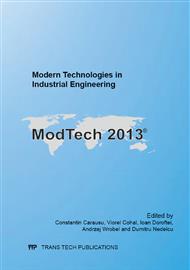p.290
p.296
p.305
p.310
p.316
p.322
p.328
p.334
p.340
The Stress Distribution of a Layered Contact Cam Mechanism Using Finite Element
Abstract:
This paper analyses the stress distribution of deposited cams by means of finite element method. The modelling of the internal tension state was made as a comparison between two types of cam mechanism configurations: a cam and plane cam follower with metallic coating deposited on the contact surface and cam with metallic coating and plane cam follower. The model used in the simulation was made in Solidworks. The model includes the geometry of the cam and cam follower and their assembly with coatings and the definition of the materials properties. The material properties used are those of 18MnCr11 for the base material and 40Cr130 for the coating. The defined geometric model was imported to the Static Structural module from Ansys 13.
Info:
Periodical:
Pages:
316-321
Citation:
Online since:
November 2013
Keywords:
Price:
Сopyright:
© 2014 Trans Tech Publications Ltd. All Rights Reserved
Share:
Citation:


